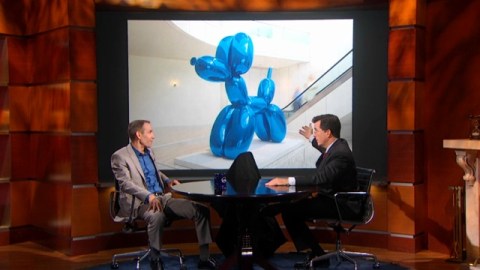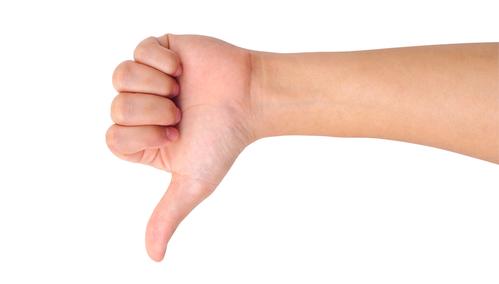Will Jeff Koons Feel the Colbert Bump?

Love him or hate him, Jeff Koons clings to the center of the contemporary art world like few artists today. And love him or hate him, Stephen Colbert and his show The Colbert Report act like a cultural epicenter, sending shock waves through the zeitgeist. When Koons appeared on The Colbert Report last week, he found himself ready to ride that wave of sudden success that Colbert himself refers to as the “Colbert bump.” If Koons ends up feeling the Colbert bump, what will it mean not only for him, but for contemporary art itself?
After referencing Koons’ highly priced, famous/infamous, oversized balloon animal sculptures, Colbert introduced Koons as the “world’s most expensive birthday clown” before making his signature romp from the big desk to the interview table. That opening joke set the tone for the gently teasing interview that followed. Koons came onto the show to promote Studio in a School, an organization that has provided art education for “hundreds of thousands of New York City children in under-served public schools, daycare centers, and community-based organizations” for 35 years. Of course, Koons came on to promote himself as well—it’s his default setting—but he knew that he’d get the classic Colbert treatment via Colbert’s faux conservative persona.
Colbert dived right into poking fun at Koons signature pieces: the balloon animal (shown above) and the basketball suspended in a water tank. Colbert joked that he liked Koons’ art because it was shiny enough for the viewer to see their reflection, which was perfect for Colbert’s narcissistic broadcaster shtick. Koons smiled and replied that “the art isn’t in the object” but, rather, “inside you, the viewer.” Koons later tried to sell the significance of the balloon animal sculpture by explaining that balloons inflate and fill us with hope, but they also deflate and depress us, so inflated balloons are better. Ever the salesman, Koons made his pitch, but Colbert didn’t seem to be buying.
I enjoy Colbert’s interviewing skills. He usually brings out the best in his subject, assuming they don’t try to out-funny him. Koons’ laconic speaking style and oddly low energy level really hurt the pace of the interview. When Colbert put a drawing by a student who benefitted from the Studio in School program up on the screen, he asked Koons if he could draw like that. Weakly defensive, Koons blandly replied that he can draw and paint, too. Koons, who conceives his art but doesn’t actually make it, must have anticipated that question—a classic dig not only at him personally, but also at contemporary art in general. If that was the meanest Colbert got, Koons got off easy. If Colbert wanted to go for the throat and for the laughs, asking Koons about his Italian porn star ex-wife would have done it.
After appearing on The Colbert Report, novelists and filmmakers see profits soar and politicians see fundraising rise. I don’t think (hope?) that Koons’ prices will get any higher, but at the very least Koons’ public profile will be a little bigger. Otherwise educated people who knew nothing of Koons before, do now. It’s admirable that Koons is connected to Studio in a School and lent his name recognition to their publicity, but I wish another contemporary artist with more serious work could have appeared with Colbert. Mockery would have been made (it is a comedy show), but at least mockery of modern art wouldn’t have been so solidly reinforced. I only hope that contemporary art doesn’t get a reverse Colbert bump even further down in the estimation of the general public.





